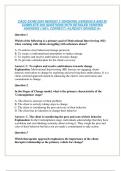Exam (elaborations)
CADC EXAM 2024 NEWEST 2 VERSIONS (VERSION A AND B) COMPLETE 250 QUESTIONS WITH DETAILED VERIFIED ANSWERS (100% CORRECT) /ALREADY GRADED A+
- Course
- Institution
CADC EXAM 2024 NEWEST 2 VERSIONS (VERSION A AND B) COMPLETE 250 QUESTIONS WITH DETAILED VERIFIED ANSWERS (100% CORRECT) /ALREADY GRADED A+
[Show more]



